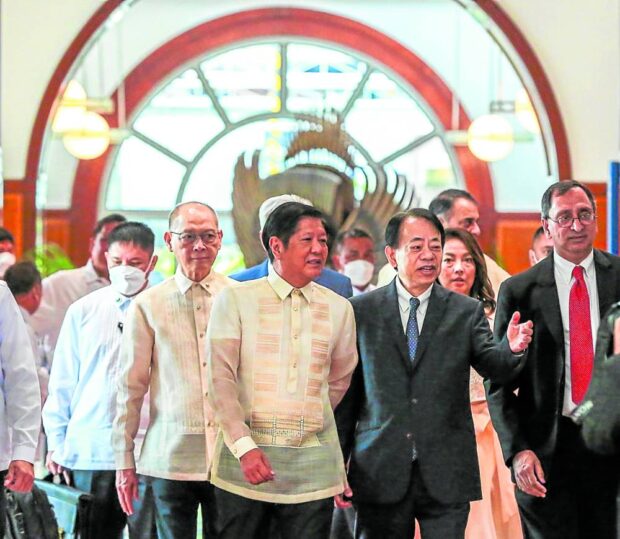
President Ferdinand R. Marcos Jr., together with some of his Cabinet members, visits the Asian Development Bank at the ADB Headquarters in Mandaluyong City on Monday (May 22, 2023).
(File photo by PPA POOL/ NOEL PABALATE)
MANILA, Philippines — President Ferdinand “Bongbong” Marcos Jr. on Wednesday approved the Masagana Rice Industry Development Program (MRIDP), which seeks to achieve the highest possible rice sufficiency level by implementing several strategies.
The Presidential Communications Office (PCO) said Marcos approved the project at the rice industry meeting held at the National Irrigation Industry.
To address rice industry challenges, the Department of Agriculture (DA), led by the President, developed MRIDP to aid farmers, boost production, and enhance the rice value chain.
PCO said the plan involves climate adaptation, farm grouping, combined efforts, value chain methods, and digital change.
The convergence of all rice industry stakeholders to pool resources, share knowledge, and coordinate efforts to achieve sustainable rice production and greater rice farmer income is a significant component of MRIDP.
In the meeting, Marcos emphasized prioritizing Filipino welfare and boosting agricultural output.
“Kaya natin ginagawa ito, hindi lamang para mapakain natin ang buong Pilipinas pero para pagandahin natin ang buhay ng ating mga magsasaka – disente naman ang buhay nila, mapag-aral nila ‘yung mga anak nila,” he said during the meeting, as quoted by PCO.
(That’s why we’re doing this, not only to feed the whole country but also to improve the lives of our farmers — where they are living comfortably and can send their children to school.)
“They have a possibility to expand, to go into other economic activities, sa agriculture or not. But to give them more opportunities. That’s the whole point. As much as possible, we will support the farmers,” Marcos added.
The President also mentioned several initiatives needed to aid farmers and improve their lives such as the consolidation and the organization of more cooperatives for their capital requirements.
Through convergence, he said, assets, resources, funding, as well as technology, can be made readily available to the farmers for their benefit.
“So, the importance of consolidation is key. That really is the first step. We cannot do all of the other things that we want to do hanggang ma-organize natin ang mga farmers natin (until we organize our farmers),” he said.
Marcos also mentioned mechanization, the adoption of new farming technologies, and digitalization as ways to help farmers.
“We have to mechanize. And then there are new technologies na talagang dapat nating tingnan, but we are not there yet. Ang maganda sa technology is that when you adopt the technology, you don’t adopt a 20-year-old technology,” he said.
(And then there are new technologies that we need to look at but we are not there yet. What’s great about technology is when you adopt it, you don’t adopt a 20-year-old technology.)
“You adopt the technology just developed yesterday kaya ‘yung state-of-the-art kaagad. And that is the big advantage of using technologies,” he added.
(It should be state-of-the-art already.)
There is also a need to build certain capacities and improve the value chain to prop up agricultural productivity and assist farmers, he noted.
PCO said the meeting aims to foster cooperation, collaboration, and convergence among government offices involved in developing the rice industry.
Data from the Department of Agriculture (DA) showed a decline in the total palay harvest area and average palay yield in 2022.
It reported of the 19.76 million metric tons (MMT) of palay in 2022, 14.94 MMT (75.6 percent) came from irrigated areas and 4.82 MMT (24.4 percent) from non-irrigated areas.
The top five highest rice-producing regions in 2022 were: Central Luzon, 3.62 MMT; Cagayan Valley, 2.93 MMT; Western Visayas, 2.32 MMT; Ilocos Region, 1.96 MMT; and, Bicol Region, 1.33 MMT.
DA is preparing measures to respond to El Niño, including early rice seed distribution, distribution of drought-tolerant planting materials, promotion of crop insurance, and irrigation scheduling, PCO said.
RELATED STORIES:
DA promotes balanced fertilization to ramp up rice growth production
Rice prices expected to rise – DA